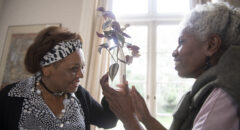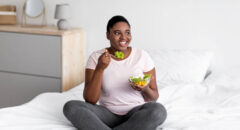 Do you weigh more than you did ten years ago, or even five years ago? The extra pounds snuck up on you, accumulated gradually before you even realized it, and now you’re looking at some serious extra poundage. But that’s to be expected as you get older, right?
Do you weigh more than you did ten years ago, or even five years ago? The extra pounds snuck up on you, accumulated gradually before you even realized it, and now you’re looking at some serious extra poundage. But that’s to be expected as you get older, right?
Wrong.
Putting on excess weight is very common for a number of reasons, but it’s not necessarily an inevitable part of the aging process — as it could put your health at risk. If you understand why you tend to gain weight more easily as you get older, you can do something about it before it becomes a problem for your health.
You can blame a lot of your weight gain on your metabolism. Beginning as early as your mid-twenties, body fat begins to increase while muscle mass decreases. And less muscle mass translates into a slower metabolic rate. Muscle mass decreases from about 45 percent of your total body weight in your youth to about 27 percent by the time you reach age 70. And the drop in hormones that accompanies menopause also precipitates a decrease in muscle mass, triggering even more weight gain for women. Your body fat, meanwhile, can double, even if your weight remains the same.
The bottom line is that you burn fewer calories in your 50s, 60s, or 70s doing the same activities, and the same number of them, that you did in your 20s, 30s, or 40s. The key to preventing weight gain is to compensate by adjusting your food intake, exercising, and generally becoming more physically active.
Now that you have made the decision to lose weight, it’s time to figure how much weight you need to lose.
Demystifying Food
Before you can take control of your eating habits, you have to take away the power that food has over you. In the process, you can begin to look at what you put on your plate as a positive power instead of an evil force over which you’ve lost all control.
- Think moderation, not elimination. Figure out what’s important and what’s not. Learn to eat less of the high-fat, high-calorie foods you enjoy the most. Knowing you can still look forward to your favorite foods makes the process something you can live with for a lifetime.
- Eat regularly in response to real hunger. Learn to listen to your body’s cues. By eating healthful, balanced meals and snacks when you’re hungry, you’re less likely to get caught up in out-of-control eating that you’ll regret later.
- Say good-bye to calorie counting. Switch your focus from calories to good nutrition. Make your healthful eating changes gradual, so you don’t get overwhelmed.
- Picture portions. It’s hard to manage your food intake if you don’t have a clue what a 1/2 cup serving of pasta looks like or what a 6-ounce glass of juice is. When you start out, measure your food until you’ve learned to judge portion sizes accurately. If portion sizes start creeping back up, return to measuring and weighing for a while.
- Disconnect with the scale. Don’t focus on a number, instead use how you feel and the way your clothes fit to measure success. If you just can’t give up the scale, make your weigh-ins less frequent. Weighing yourself once a week is adequate.
Assessing Your Weight As You Get Older
Knowing how many calories you need each day is another important piece of information that will help you manage your weight. Most experts say that 2,000 to 2,600 calories a day should meet the energy needs of men older than 50 who are lightly to moderately active.
For women over 50 who are lightly to moderately active, 1,600 to 1,800 calories a day should do it. However, these are just ballpark figures. Individual calorie needs can differ greatly depending on muscle mass, physical activity, and genetic differences.
While it’s true that the more calories you cut, the quicker you’ll lose, don’t make the mistake of cutting back too much. If you go too low (below 1,600 calories a day), you won’t get enough nutrients, you’ll be fatigued, and your body will simply compensate by slowing its metabolic rate even further so that each calorie is used as efficiently as possible.
A slower metabolic rate means that your food sacrifices won’t amount to the weight loss you expected: You’ll have sacrificed for little reward.
For women: Multiply your goal or ideal weight by 13.2 to get your daily calorie needs.
For men: Multiply your goal or ideal weight by 13.5 to get your daily calorie needs.
Getting More Physical Activity as a Senior
If you’re determined to succeed at losing weight, simply cutting calories won’t guarantee success. Physical activity is as essential to achieving long-term weight loss as a healthful diet, according to the National Institutes of Health (NIH). By themselves, neither exercise nor diet can get you to your goal as effectively or as fast as the two of them can together. That’s especially true for people over age 50.
Not only is physical activity essential for weight-loss success, the NIH says it’s an important factor in maintaining your weight once you’ve lost the extra pounds. Take comfort in the NIH’s use of the words “physical activity,” not “exercise.”
The message is that you can win the weight-loss game with many different kinds of physical activity. You don’t have to do killer aerobics and lift heavy weights at a gym to drop pounds and keep them off. But you do have to do something, and you have to do it regularly.
Anti-Aging Bonus
Researchers have recently learned that regular physical activity can have a powerful effect on age-related declines in metabolism. One study out of Tufts University Center for Physical Fitness found that strength training by itself increased the metabolic rate of postmenopausal women by 15 percent. Not much, you say?
If the boost translates to only 100 calories a day, which is a realistic expectation, you could save yourself from putting on an extra 10 pounds in a year. Regular exercise offers a trifecta of good health: It burns calories, builds muscle, and improves your overall health. Experts on aging say that the body is better able to repair itself and perform efficiently if it is properly conditioned by exercise and good nutrition.
And the calorie-burning rewards of exercise are not limited to your workout time. Some research suggests that your revved up metabolic rate stays elevated for several hours after you stop exercising.
While weight management may be your number one priority now, think fitness not thinness. Just look at all the other health bonuses experts attribute to being physically active:
Regular physical activity reduces your risk of developing:
- Heart disease
- Some kinds of cancer
- High blood pressure
- Osteoporosis
- Diabetes
- Obesity
It also can reduce the symptoms of:
- Arthritis
- Anxiety
- Depression
- Insomnia
It boosts and builds:
- The immune system
- Your energy level
- Your muscle mass
- Blood flow to the brain, which helps keep you mentally sharp
So how should you get started? It doesn’t matter how you begin, just get moving! Any activity is better than vegetating in front of the television. Look for every opportunity you can to stand instead of sit, walk instead of drive, or run instead of walk. Turn your everyday activities into opportunities for physical activity, such as taking the stairs instead of the elevator. Make movement a routine part of your everyday life.
Triad of Physical Activity
Recent research has found that when it comes to exercise, you need a combination of three types to reap the most health benefits — weight training for strength, aerobic exercise for strength and endurance, and calisthenics (stretching, bending, and twisting exercises) for flexibility.
Studies have found that extreme physical exertion is no more useful to gaining and maintaining fitness than is moderate exercise. What’s more, you place yourself at risk for injury or a heart attack if you’re not already in good physical shape. So start off slowly and increase your activity gradually. Get your doctor’s okay before beginning a new physical activity if you haven’t exercised in years or have a medical condition.
The Benefits of Walking
One of the easiest ways to get physically active is to walk at a pace that makes you breathe a little harder and work up a mild sweat for 30 minutes to 1 hour three days a week. This kind of walking will keep your heart, lungs, and vascular system in good working order and strengthen your bones and muscles.
If you just don’t have time for a 30-minute walk each day, experts say that walking about 10,000 steps a day (the equivalent of about five miles) while doing your normal activities should keep you fit.
Haven’t a clue how much walking that is? Try using a pedometer. It’s a small battery-operated gizmo about the size of a matchbox that you attach to your waist so it can monitor your every step. By keeping track of your movements all day, you can easily see how far you’ve gone and how far you have yet to go to reach your goal.
Swim Your Way to Fitness
If you have arthritis that makes some movements painful, swimming is an excellent way to get aerobically fit. It offers some of the same benefits as walking or other aerobic exercises without putting stress on joints that may be unable to repair themselves like healthy joints would. The one benefit swimming can’t provide, however, is strengthening bones because it is not a weight-bearing exercise.
Weight Training for Seniors
If you think lifting weights is just for 20-somethings in spandex, think again. It’s a little-appreciated fact that muscle tissue burns more calories than fat tissue does, even when at rest. The more muscle you have, the more calories you burn.
Since muscle mass declines with age — typically about five percent per decade beginning in your late twenties or early thirties — it’s to your advantage to try to increase your muscle mass through strength training. The older you get, the greater the potential benefit. So, as the saying goes, use it or lose it.
Research from the United States Department of Agriculture (USDA) recently confirmed that the gradual loss of muscle mass that occurs with age means a decreasing need for calories — and sometimes a creeping weight gain if you don’t lower your calorie intake. The more you can do to minimize the effect of muscle loss, whether it’s due to age, inactivity, or both, the easier weight loss will be.
But before you start trying to bench-press your own body weight, it’s important to distinguish between true weight lifting and strength training. Weight lifting is about bulking up so you can lift heavy weights swiftly. Strength training, on the other hand, is about firming by repeatedly lifting weights in a very slow, controlled way.
It’s a good idea when you first get started to have a trainer show you exactly how it should be done to avoid injury. Your training can be done with free weights, such as barbells, or with specially designed equipment that works specific parts of the body.
You should do a set number of repetitions with each exercise as you slowly progress to your goal. Muscle strengthening exercises should be done for at least 20 minutes, three times a week.








